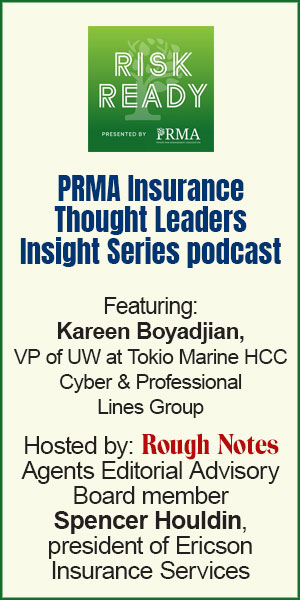As risks cross over into more than one business area,
professionals need to respond to a complex web of exposure
By Lori Widmer
If 2025 will be remembered for anything, it could be that it became the year that ushered in the need for organizations to look at risks across the entire enterprise. On the heels of several industry reports showing a marked increase in the connectivity of top risks comes a sobering realization; risks are no longer single exposures or events.
“Companies are not only facing off against criminal hackers, but now
they are facing organized crime and sovereign intelligence operations that hide behind deputized independent cyber attackers.”
—Harold Weston
Clinical Associate Professor and WSIA Distinguished Chair in Risk Management and Insurance
Maurice R. Greenberg School of Risk Science, Georgia State University
Instead, risks are now seen to be crossing over into more than one business area, creating a complex web of loss exposure. While there are still specific exposures that keep risk managers up at night—cyber loss, AI, business interruption, and natural catastrophes to name a few—the ways in which those risks are approached must change.
The cyber dilemma
With little exception, cyber incidents are top of mind throughout the commercial insurance industry. The Allianz Risk Barometer for 2025 shows that, for the first time, cyber incidents have become the primary risk focus for 38% of risk management respondents. Not far behind is business interruption, which was listed by 31% of respondents, followed by natural catastrophes (29%).
William Hughes, senior vice president of commercial lines for Arbella Insurance Group, sees that interconnectedness as a dual-edged sword. Hackers are becoming savvier at “tricking employees and business owners into releasing funds or sharing sensitive information about their customers through more empathetic phishing attempts, creating additional vulnerabilities,” he says. “While artificial intelligence (AI) and similar tools can be a benefit, cyber criminals are also using AI to become more sophisticated with their hacking efforts.”
“Cyber is a top risk in every direction,” says Harold Weston, clinical associate professor and WSIA Distinguished Chair in Risk Management and Insurance at the Maurice R. Greenberg School of Risk Science, Georgia State University. The Allianz study shows just how critical the risk has become to the C-suite: 33% of executives named it on their list of top threats to the company. The fact that 47% of them are putting off cybersecurity updates and 46% are delaying tech upgrades could well exacerbate the problem.
Yet Weston sees an even more insidious risk stemming from the cyber world. He cites “… the war being waged by China and Russia against the U.S. and its companies and infrastructure. Companies are not only facing off against criminal hackers, but now they are facing organized crime and sovereign intelligence operations that hide behind deputized independent cyber attackers. It is not only the civilian infrastructure of water systems, communications systems and electric grids as targets; every company is a cyber-war target.”
“AI continues to present unique and intricate risks that vary across industries and the way it is being leveraged,” says Christina Villena, vice president of risk solutions at The Hanover. “Generative AI can pose risks ranging from a lack of transparency to intellectual property infringements, such as content creation that inadvertently infringes on copyrights. Security concerns can also arise as the technology may be exploited, which can lead to privacy breaches.”
Beyond cyber
Cyber aside, organizations are still grappling with other significant risks. “Severe weather events are driving property damage across the industry, especially as these events have increased in frequency,” says Villena. “The wildfires in the West, the cold weather hitting the South and the prolonged deep freeze events in the North have all resulted in increased claims across our industry.”
Even those risks that might not seem so severe are racking up sizable losses. “Commercial auto continues to be a huge concern for risk managers,” says Dan Grant, director of safety service for Sentry Insurance. “Legal abuse, distracted driving, and an erosion in the quality of all types of drivers is leading to rapidly increasing losses in this area.”
“Generative AI can pose risks ranging from a lack of transparency to intellectual property infringements, such as content creation that inadvertently infringes on copyrights.”
—Christina Villena
Vice President, Risk Solutions
The Hanover

Grant sees emerging challenges for smaller fleets, where the flight to safety has quality drivers migrating to larger fleets with stronger safety departments. “This is leaving the smaller fleets with limited resources to support drivers that could use additional assistance with safety performance.”
That represents on a small scale another top challenge: worker hiring and retention. “Hiring and retaining employees of all experience levels is increasingly challenging across many industries,” Grant says. “As businesses grapple with increasing turnover and less experienced staff in critical labor positions, this can increase risk for the organization.
“Companies are having to dedicate more resources to onboarding, providing safety and risk training, only to see those employees depart after a short employment duration,” he adds.
That’s if you can find the workers. “Labor shortages are a concern, which can result in businesses hiring unqualified workers, or workers working more overtime hours, both of which can increase the risk of injuries,” says Villena.
That scenario is all too common; Allianz reports that 48% of executives surveyed admit that existing employees are being asked to work longer hours or take fewer breaks, and 43% of employers are increasing output expectations.
“Liability costs … are increasing, possibly impacted by inflation as well as dynamics seen in the
litigation system, where higher (nuclear) verdicts are, in part, driving severity of claims”
—William Hughes
Senior Vice President, Commercial Lines
Arbella Insurance Group

Then there’s the cost of claims, which Grant says is putting pressure on budgets. “As medical treatment and vehicle/equipment repairs costs remain at all-time highs, companies experiencing even moderate cases of worker injuries or equipment damage are consuming much greater percentages of funds allocated to cover those events.”
“Liability costs, particularly for commercial automobile and general liability claims, are increasing, possibly impacted by inflation as well as dynamics seen in the litigation system, where higher (nuclear) verdicts are, in part, driving severity of claims,” says Hughes. “This uncertainty puts pressure on both carriers in projecting loss costs for these lines of coverage and for business owners trying to protect their balance sheets.”
The social inflation created by nuclear verdicts “give ever higher verdicts way beyond what most people would previously have thought a case is worth at any top end,” Weston adds. “Related to that is litigation funding by private equity and foreign investors that turn lawsuits into investment opportunities against insurers and large corporations. This makes it hard to know how much insurance to buy, how much losses to reserve or budget for, and how much to settle for.”
Villena sees the same social inflation. “Nuclear verdicts, those of $10 million or more, are becoming an issue for our industry. The U.S. Chamber of Commerce Institute for Legal Reform completed a study last year that showed jury awards of this amount are only increasing in size and frequency, with product liability and auto accident cases with some of the highest median verdicts. This is often fueled by-third party litigation financing.”
Helping clients find balance
All of this means that clients will be turning to the independent agent and broker community for answers. Hughes says that the resources and expertise that agents and brokers can provide become invaluable to clients. “There is a great deal of advertising aimed at customers and business owners with a focus on lowering premiums.
“However, an effective insurance program runs much deeper than just the up-front premium cost,” he adds. When customers and agents review the business together, the surprises are kept to a minimum. “Collaboration with the insurance company can be a vital advantage in the areas of loss control and managing risk,” Hughes notes.
Selling on price, Grant says, makes little sense and delivers nothing of value to the client. “Brokers can best address risk management issues with clients by being straightforward with their clients. Insurance costs are not going to go down if claim frequency and severity is not reduced. While strategy is a critical part of risk management, safety performance is key.”

“Commercial auto continues to be a huge cocern … . Legal abuse, distracted driving, and an erosion in the quality of all types of drivers is leading to rapidly increasing losses in this area.”
—Dan Grant
Director, Safety Service
Sentry Insurance
He suggests that insureds partner with insurers to take advantage of their internal expertise and tools. “By working closely with safety and claims, insurance carriers get a better understanding of their insureds and can see the priority that is given to loss prevention and mitigation.”
Weston suggests that agents and brokers keep one thing in mind when meeting with clients: “Don’t sell. Solve.”
Villena believes that a partnership among insurers and agents can empower clients with both expertise and knowledge about new and existing tools and resources. “We are living in a very dynamic environment with emerging risks impacting multiple facets of a business—from worker safety, to property, to business continuity, and much more.
“Fortunately, as new risks emerge, new technologies and solutions quickly follow,” she adds. “Carriers and agents can continue to partner together to bring these resources to their customers, helping to best protect their businesses for years to come.”
For more information:
Arbella Insurance Group
arbella.com
The Hanover
hanover.com
Maurice R. Greenberg School of Risk Science, Georgia State University
robinson.gsu.edu/academic-departments/risk-science
Sentry Insurance
sentry.com
The author
Lori Widmer is a Philadelphia-based writer and editor who specializes in insurance and risk management.






